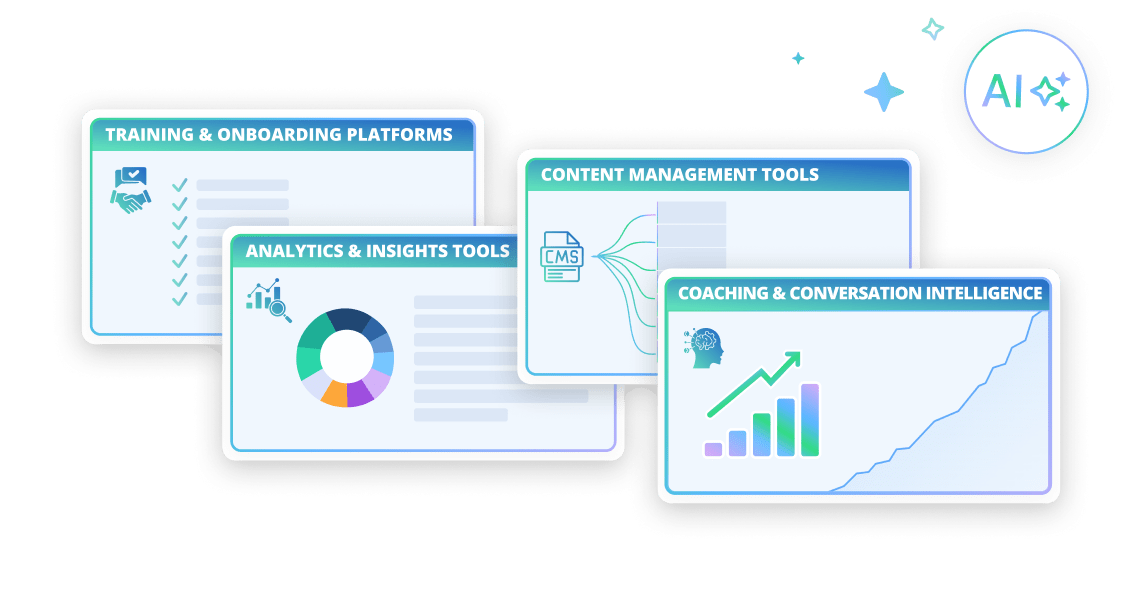Key Takeaways
|
|
|
|
Ask ten sales leaders to define “sales enablement tools,” and you’ll likely get ten different answers. That confusion comes at a cost: fragmented tech stacks, underused platforms, and wasted budget. The reality is that modern selling demands far more than scattered point solutions. Today’s revenue teams need structured onboarding, smarter coaching, and AI-driven insights to keep pace with informed, cautious buyers. That’s where sales enablement tools come in.
In this beginner’s guide, we’ll break down what they are, the core types you need to know, and real-world examples of how they drive impact. We’ll also share practical advice on choosing the right tools for your team. Along the way, you’ll see why SalesHood is helping companies scale revenue with precision and repeatability.
What are Sales Enablement Tools?
Sales enablement tools are technologies that help revenue teams sell smarter and faster. They provide sellers with the right content, training, and insights at the exact moment they need them. Instead of hunting for files or guessing which message resonates, reps can rely on a unified system to guide them through the sales process.
The purpose of these tools is clear: to organize sales content, ramp new reps more quickly, and enable managers to coach effectively. When done right, enablement creates consistency across the team, improves efficiency, and delivers measurable pipeline impact. That means shorter ramp times, higher win rates, and stronger customer relationships.
For companies looking to scale without the chaos of disconnected tools, platforms like SalesHood unify training, coaching, and content activation into one AI-powered ecosystem.
Core Types of Sales Enablement Tools
Not all sales enablement tools are created equal. To understand the landscape, here are the core categories you need to know.
Training & Onboarding Platforms
These platforms help new reps ramp faster and keep seasoned sellers sharp. They provide structured learning paths, micro-learning modules, and role-based onboarding programs.
With SalesHood’s Training & Onboarding, companies accelerate readiness and reduce ramp time by delivering consistent, measurable learning experiences.
Content Management Tools
Sales reps often waste hours searching for the right deck or case study. Content management tools solve that by centralizing assets and guiding sellers on what to use, and when.
SalesHood’s Content Management ensures teams share the most impactful content at the right stage of the buyer journey.
Analytics & Insights Tools
Data turns enablement into measurable impact. These tools track which content influences deals, how training affects readiness, and where reps are getting stuck.
Recent industry research shows that teams with formal sales enablement see ~49% win rates on forecasted deals, highlighting the impact of data-driven enablement.
Coaching & Conversation Intelligence
Great managers don’t just tell reps what to improve, they show them. Coaching and conversation intelligence tools provide call recaps, conversation analysis, and AI-driven feedback.
SalesHood’s Coaching Solutions let managers deliver personalized, data-backed coaching at scale.
How Sales Enablement Delivers Measurable Results
Theory is great, but results speak louder. Here are three practical ways companies are using sales enablement tools to win bigger:
- Onboarding reps faster with structured training: Companies using SalesHood’s Training & Onboarding cut ramp time dramatically. Structured learning paths and peer-to-peer exercises ensure new hires are productive in weeks, not months.
- Doubling win rates by activating the right content: With SalesHood’s Content Management, sellers know exactly which assets to share at each stage. The result? More engaged buyers and deals that move forward faster.
- Coaching at scale with AI insights: SalesHood’s Coaching Solutions help sales managers analyze calls and uncover coaching opportunities. Personalized feedback replaces guesswork, thereby saving time and driving results.
How to Choose the Right Sales Enablement Tools
Choosing the right solution starts with understanding your team’s unique needs and growth stage.
- Smaller teams may prioritize ease of use, while larger enterprises often need scalability and global consistency.
- Another factor is sales cycle complexity. If your deals involve multiple stakeholders and longer timelines, you’ll want tools that support buyer collaboration & visibility.
- Integration is also critical. Your enablement tools should connect seamlessly with your CRM and broader tech stack to avoid silos.
- Finally, look for AI capabilities. The next generation of enablement is about insights and coaching at scale, not just content storage or training libraries.
That’s why many revenue leaders choose SalesHood for its unified, AI-powered approach that eliminates tool sprawl. It helps teams ramp faster, sell smarter, and deliver repeatable revenue impact.
The Future of Sales Enablement is Unified and AI-Driven
Sales enablement tools are now essential for scaling success, not optional anymore.They organize content, accelerate onboarding, and give managers the insights needed to coach effectively.
But the real differentiator today is AI. The next generation of enablement is unified, data-driven, and powered by intelligence that helps sellers adapt in real time.
Ready to see how enablement accelerates growth? Explore SalesHood. From demos to eBooks to customer stories, you’ll find everything you need to transform the way your team sells.
FAQs on Sales Enablement Tools
What are sales enablement tools?
Sales enablement tools are platforms that help sales teams organize content, train reps, and use insights to close deals faster.
What are the types of sales enablement tools?
The main categories include training and onboarding platforms, content management systems, analytics and insights tools, and coaching or conversation intelligence software.
What is an example of a sales enablement tool?
Of all sales enablement examples, SalesHood differentiates itself by being a unified, AI-powered platform that combines training, coaching, and content activation.



